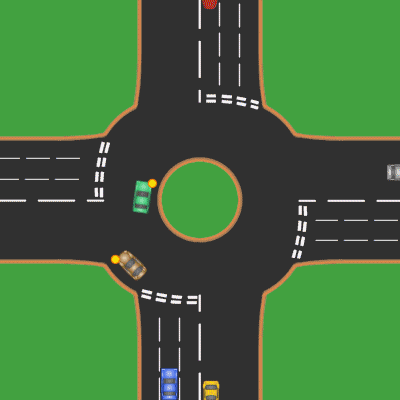

When a motorist waits at the red signal to turn green, there involves complex technology that tries to minimize congestion. There are 3-parts that enable the successful operation of a smart signaling system.
These signaling functions must operate in synergy to ensure the safe and efficient travel for motorists and pedestrians.
 Signaling Hardware
Signaling HardwareThese are the color-coded devices usually installed at the intersection or hung up on the span wires to indicate whether the motorist should stop (red), prepare to stop (yellow), or drive (green). The components of signaling hardware are frequently updated. Most smart cities have been updating the LED lights to conserve energy.
The other component of smart signaling is a vehicle or pedestrian sensor. Since last few years, we have noticed a transition from use of inductive loop sensors which work on the principle of the circuit breaker. The sensor recognizes the presence of a car or a pedestrian crossing the intersection, and it communicates the signal to the controller. These sensors are usually installed beneath the roads or pavements for detecting any movement on the street. The circuitry within the sensor monitors the electric pulse and informs controller about the presence or absence of car or pedestrian. Although it is a reliable mode of detecting an object, the installation and maintenance is an expensive and time-consuming process. Neither it detects whether it is a car or multiple cars on the street. In a traffic congested location, they are not a reliable choice.
However, with the evolution of digitization, cameras, and image processing techniques, video processing of traffic has gained importance. It is not only easy to install and maintain but also captures and transmits images in real-time to the controller. The processor within the camera compares the real-time image with the previous image to identify whether the new car is present in the detection zone.
During severe weather like snow, fog or rains, video monitoring cannot function efficiently. But video detection is still relatively cheaper to install and maintain, unlike the loop sensors which are concealed within the road.
 Signal Controller
Signal ControllerThe signaling controller is housed within a metal box at each intersection. It processes the data received from the input sensor determines the amount of time green or red light will be activated. These controllers operate in 3-modes. It can be either pre-timed, actuated or synchronized.
a. The pre-timed mode allows a pre-determined amount of time signal remain green or red irrespective of the traffic demand. It does not require any sensors or input data as the system runs on a timer. It does not assist in mitigating traffic or reducing traffic demands. It is not used anymore in urban traffic management systems.
b. In an actuated system, it does not use any time control. The sensor detects the presence of a car or a pedestrian and accordingly changes from red to green or vice-versa. This does not offer any synchronization neither the timing is equally distributed. It results in larger delay as the system does not let the busy lanes clear out faster.
c. Synchronized mode permits the cars on the main street to keep going unless the sensor detects any pedestrian or a car on the side street. This system addresses the large volume of cars main street, thus lowering traffic on the main street. Synchronization system also enables customization of time based on volume detected for the needs of commuters along the route.
The communication within signals is interconnected for optimal performance. This communication can take place wirelessly, fiber-optic cables or twister copper cables. This form of communication is applicable to entire town or a city to maintain synchronization. The overall effect of networking signals maximizes the efficiency of signal performance.

